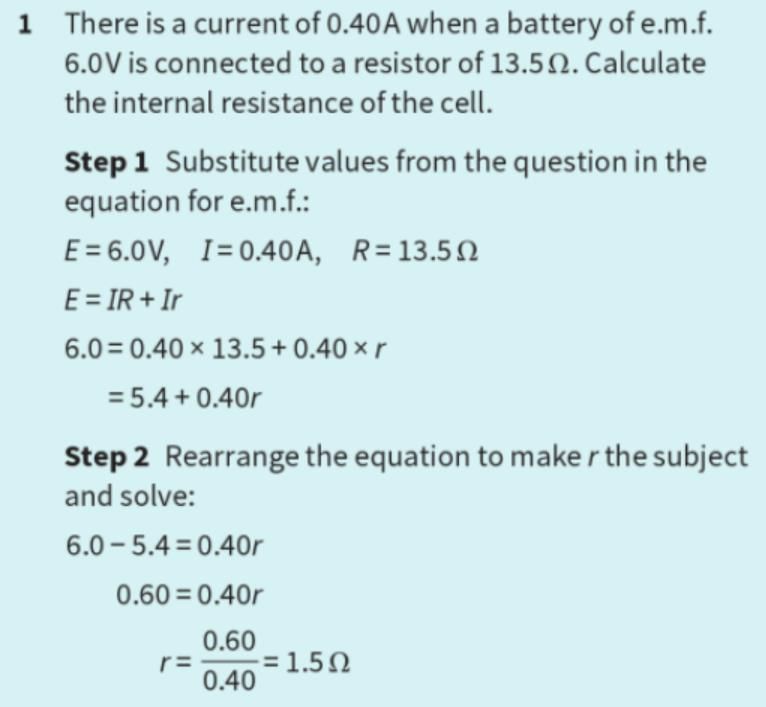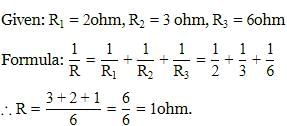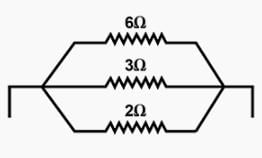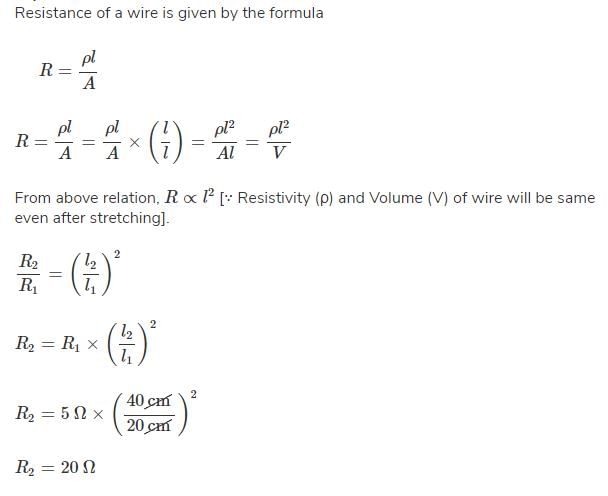All Exams >
Grade 12 >
Physics for Grade 12 >
All Questions
All questions of Current Electricity for Grade 12 Exam
Two wires of the same material having radii in the ratio 1:2, carry currents in the ratio 4 : 1. The ratio of drift velocities of electrons in them is- a)1:16
- b)16:1
- c)1:4
- d)1:1
Correct answer is option 'D'. Can you explain this answer?
Two wires of the same material having radii in the ratio 1:2, carry currents in the ratio 4 : 1. The ratio of drift velocities of electrons in them is
a)
1:16
b)
16:1
c)
1:4
d)
1:1

|
Ciel Knowledge answered |
We have the relation between current I, n = no. of carrier per unit volume, drift velocity ve and CSA A as.
I = neAv
Let current flowing in the 2nd wire I2 = I thus current flowing through the 1st wire I1 = 4I
Let the radius of the first wire be r thus radius of the 2nd wire = 2r
In the first wire
A1 = πr2
In the 2nd wire
A2 = π(2r)2 = 4πr2
I1/ I2 = (A1v1 )/(A2v2 ) (ne being same for two wires as they are made of the same material)
4I/I = πr2 v1/4 πr2v2
=> v1/v2 = 16/1
=> v1:v2 = 16:1
Thus ratio of the drift velocities are 16:1
A car battery has ________ resistance than a dry cell.- a)same
- b)much lower
- c)slightly greater
- d)much higher
Correct answer is option 'B'. Can you explain this answer?
A car battery has ________ resistance than a dry cell.
a)
same
b)
much lower
c)
slightly greater
d)
much higher
|
|
Vijay Bansal answered |
Dry cell car batteries consist of a fiberglass mat that contains electrolytes. The electrolytes cause a chemical reaction that produces electricity. ... Although dry cell car batteries are expensive, they last longer than conventional wet cell batteries. They also have more power to crank the car's engine in bad weather.
The following fig. shows I-V graph for a given metallic wire at two temperatures T1and T2.Then,
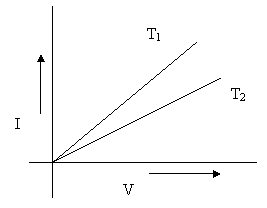
- a)Temperature T2 is less
- b)Temperature T2 is more
- c)T1 is same as T2
- d)None of the above
Correct answer is option 'B'. Can you explain this answer?
The following fig. shows I-V graph for a given metallic wire at two temperatures T1and T2.Then,
a)
Temperature T2 is less
b)
Temperature T2 is more
c)
T1 is same as T2
d)
None of the above

|
Knowledge Hub answered |
The slope of the graph = I / V
In case of T2, I/V is less. Hence, V/I (=R) is more.
Value of resistance increases with increasing temperature.
Hence, T2 >T
Five resistances are connected as shown in fig. The effective resistance between points A and B is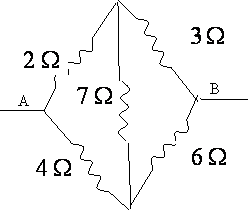
- a)20/30Ω
- b)15Ω
- c)10/3Ω
- d)6Ω
Correct answer is option 'C'. Can you explain this answer?
Five resistances are connected as shown in fig. The effective resistance between points A and B is
a)
20/30Ω
b)
15Ω
c)
10/3Ω
d)
6Ω

|
Lekshmi Basu answered |
The given circuit is a balanced Wheatstone bridge type, hence it can be simplified 

When the position of cell and galvanometer in a Wheatstone bridge is inter-changed, its balanced condition- a)Changes and depends on galvanometer position only
- b)Changes
- c)Changes and it depends on cell position only
- d)Remains unchanged
Correct answer is option 'D'. Can you explain this answer?
When the position of cell and galvanometer in a Wheatstone bridge is inter-changed, its balanced condition
a)
Changes and depends on galvanometer position only
b)
Changes
c)
Changes and it depends on cell position only
d)
Remains unchanged
|
|
Krishna Iyer answered |
For balanced Wheatstone bridge which is shown in figure a, P/Q=S/R
If we interchange the cell and galvanometer then circuit becomes as shown in figure b.
and balanced condition, P/S=Q/R⇒P/Q=S/R
Thus, balanced point remains unchanged.
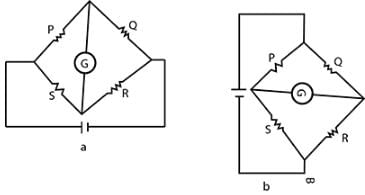
If we interchange the cell and galvanometer then circuit becomes as shown in figure b.
and balanced condition, P/S=Q/R⇒P/Q=S/R
Thus, balanced point remains unchanged.

A wire has a non-uniform cross-section as shown in figure. A steady current flows through it. The drift speed of electrons at points P and q is vp and vQ.
- a)vp = vQ
- b)vp < vQ
- c)vp > vQ
- d)Data insufficient
Correct answer is option 'C'. Can you explain this answer?
A wire has a non-uniform cross-section as shown in figure. A steady current flows through it. The drift speed of electrons at points P and q is vp and vQ.
a)
vp = vQ
b)
vp < vQ
c)
vp > vQ
d)
Data insufficient
|
|
Krishna Iyer answered |
The drift speed of electrons is inversely proportional to the radius of cross section.
Thus here the cross-sectional area at point P is smaller than the cross-sectional area at point Q. Hence, the drift velocity is large for smaller area and small for larger area. The drift speed will relate as per the relation given below
vP>vQ
Thus here the cross-sectional area at point P is smaller than the cross-sectional area at point Q. Hence, the drift velocity is large for smaller area and small for larger area. The drift speed will relate as per the relation given below
vP>vQ
Under what condition, the current drawn from the cell is maximum?- a)R = r
- b)R > r
- c)R = 0
- d)R < r
Correct answer is option 'C'. Can you explain this answer?
Under what condition, the current drawn from the cell is maximum?
a)
R = r
b)
R > r
c)
R = 0
d)
R < r
|
|
Ritu Singh answered |
The maximum current can be drawn from a cell if the external resistance R = 0.
When current is to be drawn at max then the conducting wire rating comes high such that resistance is less.
Resistance R = rho x l/a
Rho = resistivity constant
L=length
a=area of cross-section
Hence, if the area of cross-section increases resistance decreases by increasing the rate of current to flow.
How many electrons are flowing per second through a section of a conductor corresponding to current of 1A?- a)7. 00 × 1018
- b)6.25 × 1018
- c)3.25 × 1016
- d)4.75 × 1017
Correct answer is 'B'. Can you explain this answer?
How many electrons are flowing per second through a section of a conductor corresponding to current of 1A?
a)
7. 00 × 1018
b)
6.25 × 1018
c)
3.25 × 1016
d)
4.75 × 1017

|
Vishal Giri answered |
I = q / t but we know q = n*e# where n = no. of electrons and e = charge on one electron. Let's put:: q=n*e we get I = n*e / t we know from given information that =============>I = 1A,,,,, t =1 s,,,, e = 1.602 * 10^ -19 C. put all these values in above equation we get 1 = n* 1.6 *10^ -19/ 1 hence n = 1 / 1.6*10^ -19 n = 0.625 * 10^ 19 n = 6.25 * 10^ 18IS THE UR ANSWER.
Specific resistance of a conductor increases with- a)Increase in cross-section and decrease in length
- b)Increase in cross-section
- c)Decrease in cross-section
- d)Increase in temperature
Correct answer is option 'D'. Can you explain this answer?
Specific resistance of a conductor increases with
a)
Increase in cross-section and decrease in length
b)
Increase in cross-section
c)
Decrease in cross-section
d)
Increase in temperature
|
|
Anjana Sharma answered |
Therefore resistance increases with the length. When cross sectional area increases the space of the elctrons to travel increases(simply explained). Therefore less amount of obstacles for the current. Therefore when area increases the resistance decreases.
Two cells of 1.25 V and 0.75V are connected in parallel. The effective voltage will be- a)0.5 V
- b)2.00 V
- c)1.25 V
- d)0.75 V
Correct answer is option 'A'. Can you explain this answer?
Two cells of 1.25 V and 0.75V are connected in parallel. The effective voltage will be
a)
0.5 V
b)
2.00 V
c)
1.25 V
d)
0.75 V
|
|
Anjana Sharma answered |
When two cells are conneted in parallel , then
Effective Voltage,V = V1 − V2 = 1.25 − 0.75 = 0.5 V
What is the maximum current that can be drawn from a cell of emf E and internal resistance r connected to an external resistance R?- a)I = E/(R+r)
- b)infinite
- c)I = E/R
- d)I = E/r
Correct answer is option 'D'. Can you explain this answer?
What is the maximum current that can be drawn from a cell of emf E and internal resistance r connected to an external resistance R?
a)
I = E/(R+r)
b)
infinite
c)
I = E/R
d)
I = E/r
|
|
Preeti Iyer answered |
as the maximum current that can be drawn from a cell is for R =0 therefore, it is I = E/r.
Three resistors of 4Ω, 12Ω , and 6Ω are connected in parallel. No. of 12Ω resistors required to be connected in parallel to reduce the total resistance to half of its original is- a)6
- b)3
- c)12
- d)2
Correct answer is 'A'. Can you explain this answer?
Three resistors of 4Ω, 12Ω , and 6Ω are connected in parallel. No. of 12Ω resistors required to be connected in parallel to reduce the total resistance to half of its original is
a)
6
b)
3
c)
12
d)
2
|
|
Riya Banerjee answered |
Here 4 Ω, 12 Ω, 6 Ω when connected in parallel results in 2Ω. to reduce it to half we have to join 1\R original = 6\12 for reducing it to half we have to join 6 , 12 Ω resistors in parallel (6\12) + (1\ 12 × 6) = 12\12 = 1 ohm . Half of its original value therefore option a is correct.
If cells are joined in parallel, they have _______.- a)same current
- b)same emf
- c)same potential difference
- d)same internal resistance
Correct answer is option 'C'. Can you explain this answer?
If cells are joined in parallel, they have _______.
a)
same current
b)
same emf
c)
same potential difference
d)
same internal resistance
|
|
Hansa Sharma answered |
Components connected in parallel provide alternative pathways for current flow. When cells are connected in parallel, the total voltages that they provide does not change. For example, when two or more 2 V cells are connected in parallel, they still provide a total voltage of 2 V.
When Wheatstone bridge is in balance condition, the current through galvanometer will be- a)Zero
- b)Maximum
- c)Minimum
- d)Depends upon the type of galvanometer
Correct answer is option 'A'. Can you explain this answer?
When Wheatstone bridge is in balance condition, the current through galvanometer will be
a)
Zero
b)
Maximum
c)
Minimum
d)
Depends upon the type of galvanometer
|
|
Krishna Iyer answered |
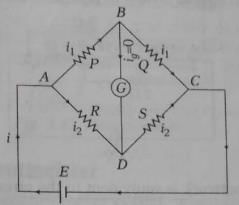
The bridge is said to be balanced when deflection in galvanometer is zero(Ig=0), i.e., no current flows through the galvanometer(branch BD).In the balanced condition,
P/Q=R/S
On mutually changing the position of the cell and galvanometer, this condition will not change.
A steady current is passing through a linear conductor of non-uniform cross-section. The current density in the conductor is- a)independent of area of cross-section
- b)directly proportional to area of cross-section
- c)inversely proportional to area of cross-section
- d)inversely proportional to the square root of area of cross-section
Correct answer is option 'C'. Can you explain this answer?
A steady current is passing through a linear conductor of non-uniform cross-section. The current density in the conductor is
a)
independent of area of cross-section
b)
directly proportional to area of cross-section
c)
inversely proportional to area of cross-section
d)
inversely proportional to the square root of area of cross-section
|
|
Anaya Patel answered |
Current density is equal to Electric current divided by a given surface area, or it is the current flowing per a given cross section area.
The current density decreases with increase in cross section area which means they are inversely proportional.
The current density decreases with increase in cross section area which means they are inversely proportional.
If the potential difference V applied on a conductor is doubled, the drift velocity of electrons will become- a)vd
- b)2vd
- c)4vd
- d)

Correct answer is option 'B'. Can you explain this answer?
If the potential difference V applied on a conductor is doubled, the drift velocity of electrons will become
a)
vd
b)
2vd
c)
4vd
d)

|
EduRev JEE answered |
Drift velocity is directly proportional to potential difference.
Drift velocity is defined as the average velocity with which free electrons get drifted towards the positive end of the conductor under the influence of an external electric field.
Drift velocity is given by
vd= eEτ/ m
But, E=V/l
(if l is length of the conductor and V is constant potential difference applied across the ends of the conductor)
∴vd= eVτ/ml
⇒vd∝V
So, when the potential difference is doubled the drift velocity will be doubled.
Note - Current flowing through a conductor is directly proportional to the drift velocity.
Drift velocity is defined as the average velocity with which free electrons get drifted towards the positive end of the conductor under the influence of an external electric field.
Drift velocity is given by
vd= eEτ/ m
But, E=V/l
(if l is length of the conductor and V is constant potential difference applied across the ends of the conductor)
∴vd= eVτ/ml
⇒vd∝V
So, when the potential difference is doubled the drift velocity will be doubled.
Note - Current flowing through a conductor is directly proportional to the drift velocity.
- a)1 ohm
- b)0.5 ohm
- c)1.5 ohm
- d)2 ohm
Correct answer is 'A'. Can you explain this answer?

|
Infinity Academy answered |
1st case[series]
I=E+E/r+r+1-----1
2nd case[parallel]
I=E[E will be same in parallel]/(1/r)+(1/r)+(1/1)----2
Current in both cases are the same.
1=2
2E/2r+1=E/(2/r)+1
R=1 Ω
I=E+E/r+r+1-----1
2nd case[parallel]
I=E[E will be same in parallel]/(1/r)+(1/r)+(1/1)----2
Current in both cases are the same.
1=2
2E/2r+1=E/(2/r)+1
R=1 Ω
1 ohm is equal to- a)1 volt per ampere
- b)1 ampere per millivolt
- c)1 milliampere per volt
- d)1 ampere per volt
Correct answer is option 'A'. Can you explain this answer?
1 ohm is equal to
a)
1 volt per ampere
b)
1 ampere per millivolt
c)
1 milliampere per volt
d)
1 ampere per volt
|
|
Anjana Sharma answered |
Reduced to base SI units, one ohm is the equivalent of one kilogram meter squared per second cubed per ampere squared (1 kg times m. s. A^-2 . The ohm is also the equivalent of a volt per ampere (V/A).
Meter Bridge or Slide Wire Bridge is a practical form of- a)Ammeter
- b)Voltmeter
- c)Wheatstone bridge
- d)Potentiometer
Correct answer is option 'C'. Can you explain this answer?
Meter Bridge or Slide Wire Bridge is a practical form of
a)
Ammeter
b)
Voltmeter
c)
Wheatstone bridge
d)
Potentiometer
|
|
Aarav Khanna answered |
Meter Bridge or Slide Wire Bridge is a practical form of Wheatstone bridge.
Wheatstone Bridge:
The Wheatstone bridge is a circuit used to measure unknown resistance by balancing it against a known resistance. It consists of four resistors arranged in a diamond shape, with a galvanometer connected between two opposite corners and a battery connected to the other two corners. When the bridge is balanced, the galvanometer shows zero deflection, indicating that the ratio of the unknown resistance to the known resistance is equal to the ratio of the other two resistors.
Meter Bridge or Slide Wire Bridge:
The meter bridge, also known as the slide wire bridge, is a practical form of the Wheatstone bridge. It consists of a long uniform wire of uniform cross-section called the meter wire, which is stretched over a wooden board. The meter wire is usually made of manganin or constantan, which have low temperature coefficients of resistance.
Construction:
The meter bridge consists of a uniform wire AB, which is connected to a galvanometer G at its midpoint. The wire is divided into two parts by a gap at the center, where a resistance box is connected. A jockey J is used to make contact with the wire and slide along its length.
Working Principle:
To measure an unknown resistance using the meter bridge, the jockey is initially placed at the midpoint of the wire (point O). The resistance box is adjusted until the galvanometer shows zero deflection. At this point, the bridge is in a balanced condition.
The principle behind the working of the meter bridge is that when the bridge is balanced, the ratio of the lengths of the two arms of the wire (AO and OB) is equal to the ratio of the resistances (R1 and R2) in the two arms. Mathematically, this can be represented as:
R1/R2 = AO/OB
By measuring the lengths AO and OB, the ratio R1/R2 can be determined. Since one of the resistances (R1 or R2) is known, the unknown resistance can be calculated.
Advantages of Meter Bridge:
1. High Accuracy: The meter bridge offers high accuracy in measuring resistance as it is based on the principle of a balanced bridge.
2. Simple Construction: The meter bridge is relatively simple in construction and easy to use.
3. Low Cost: The materials required for constructing a meter bridge are easily available and inexpensive.
4. Versatility: The meter bridge can be used to measure a wide range of resistances, making it a versatile instrument.
In conclusion, the meter bridge or slide wire bridge is a practical form of the Wheatstone bridge and is used to measure unknown resistances accurately.
Wheatstone Bridge:
The Wheatstone bridge is a circuit used to measure unknown resistance by balancing it against a known resistance. It consists of four resistors arranged in a diamond shape, with a galvanometer connected between two opposite corners and a battery connected to the other two corners. When the bridge is balanced, the galvanometer shows zero deflection, indicating that the ratio of the unknown resistance to the known resistance is equal to the ratio of the other two resistors.
Meter Bridge or Slide Wire Bridge:
The meter bridge, also known as the slide wire bridge, is a practical form of the Wheatstone bridge. It consists of a long uniform wire of uniform cross-section called the meter wire, which is stretched over a wooden board. The meter wire is usually made of manganin or constantan, which have low temperature coefficients of resistance.
Construction:
The meter bridge consists of a uniform wire AB, which is connected to a galvanometer G at its midpoint. The wire is divided into two parts by a gap at the center, where a resistance box is connected. A jockey J is used to make contact with the wire and slide along its length.
Working Principle:
To measure an unknown resistance using the meter bridge, the jockey is initially placed at the midpoint of the wire (point O). The resistance box is adjusted until the galvanometer shows zero deflection. At this point, the bridge is in a balanced condition.
The principle behind the working of the meter bridge is that when the bridge is balanced, the ratio of the lengths of the two arms of the wire (AO and OB) is equal to the ratio of the resistances (R1 and R2) in the two arms. Mathematically, this can be represented as:
R1/R2 = AO/OB
By measuring the lengths AO and OB, the ratio R1/R2 can be determined. Since one of the resistances (R1 or R2) is known, the unknown resistance can be calculated.
Advantages of Meter Bridge:
1. High Accuracy: The meter bridge offers high accuracy in measuring resistance as it is based on the principle of a balanced bridge.
2. Simple Construction: The meter bridge is relatively simple in construction and easy to use.
3. Low Cost: The materials required for constructing a meter bridge are easily available and inexpensive.
4. Versatility: The meter bridge can be used to measure a wide range of resistances, making it a versatile instrument.
In conclusion, the meter bridge or slide wire bridge is a practical form of the Wheatstone bridge and is used to measure unknown resistances accurately.
Can you explain the answer of this question below:What is current I in the circuit as shown in figure?

- A:
1 A
- B:
2.0 A
- C:
1.2 A
- D:
0.5 A
The answer is b.
What is current I in the circuit as shown in figure?
1 A
2.0 A
1.2 A
0.5 A

|
Surya answered |
Yes option B is correct... first u straight the three resistance then it change in series... so u add three u get 6 ohms... after, that 6 ohm is parallel to 3ohm so;3/2.. so as per ohms law;V=IR (since:V=3; R=3/2; I=?) 3=3/2×I I=2ampere... that's it...hope u clear...!!👍😊
At any junction, the sum of the currents entering the junction is equal to the sum of _______- a)potential around any closed loop
- b)voltages across the junction
- c)all the currents in the circuit
- d)currents leaving the junction
Correct answer is option 'D'. Can you explain this answer?
At any junction, the sum of the currents entering the junction is equal to the sum of _______
a)
potential around any closed loop
b)
voltages across the junction
c)
all the currents in the circuit
d)
currents leaving the junction

|
Om Kumar answered |
The correct answer is option 'D': currents leaving the junction.
Explanation:
At any junction in an electrical circuit, the sum of the currents entering the junction is equal to the sum of the currents leaving the junction. This is based on the principle of conservation of charge.
When current flows through a junction, it must split into multiple paths. The total amount of charge entering the junction must be equal to the total amount of charge leaving the junction. This is because charge cannot be created or destroyed, it can only flow through the circuit.
To better understand this concept, consider a simple circuit with three branches connected to a junction. Let's label the currents entering the junction as I1, I2, and I3, and the currents leaving the junction as I4, I5, and I6.
The principle of conservation of charge states that the total amount of charge entering the junction must be equal to the total amount of charge leaving the junction. Mathematically, this can be expressed as:
I1 + I2 + I3 = I4 + I5 + I6
This equation shows that the sum of the currents entering the junction (I1 + I2 + I3) is equal to the sum of the currents leaving the junction (I4 + I5 + I6).
This principle is a consequence of Kirchhoff's current law (KCL), which states that the algebraic sum of currents at any junction in an electrical circuit is zero. This means that the sum of currents entering the junction is equal to the sum of currents leaving the junction.
In summary, at any junction in an electrical circuit, the sum of the currents entering the junction is equal to the sum of the currents leaving the junction. This principle is based on the conservation of charge and is a consequence of Kirchhoff's current law.
Explanation:
At any junction in an electrical circuit, the sum of the currents entering the junction is equal to the sum of the currents leaving the junction. This is based on the principle of conservation of charge.
When current flows through a junction, it must split into multiple paths. The total amount of charge entering the junction must be equal to the total amount of charge leaving the junction. This is because charge cannot be created or destroyed, it can only flow through the circuit.
To better understand this concept, consider a simple circuit with three branches connected to a junction. Let's label the currents entering the junction as I1, I2, and I3, and the currents leaving the junction as I4, I5, and I6.
The principle of conservation of charge states that the total amount of charge entering the junction must be equal to the total amount of charge leaving the junction. Mathematically, this can be expressed as:
I1 + I2 + I3 = I4 + I5 + I6
This equation shows that the sum of the currents entering the junction (I1 + I2 + I3) is equal to the sum of the currents leaving the junction (I4 + I5 + I6).
This principle is a consequence of Kirchhoff's current law (KCL), which states that the algebraic sum of currents at any junction in an electrical circuit is zero. This means that the sum of currents entering the junction is equal to the sum of currents leaving the junction.
In summary, at any junction in an electrical circuit, the sum of the currents entering the junction is equal to the sum of the currents leaving the junction. This principle is based on the conservation of charge and is a consequence of Kirchhoff's current law.
A uniform copper wire carries a current i amperes and has p carriers per metre3. The length of the wire is  metres and its cross-section area is s metre2. If the charge on a carrier is q coulombs, the drift velocity in ms_1 is given by
metres and its cross-section area is s metre2. If the charge on a carrier is q coulombs, the drift velocity in ms_1 is given by- a)i/
 sq
sq - b)i/psq
- c)psq/i
- d)i/ps
 q
q
Correct answer is option 'B'. Can you explain this answer?
A uniform copper wire carries a current i amperes and has p carriers per metre3. The length of the wire is  metres and its cross-section area is s metre2. If the charge on a carrier is q coulombs, the drift velocity in ms_1 is given by
metres and its cross-section area is s metre2. If the charge on a carrier is q coulombs, the drift velocity in ms_1 is given by
a)
i/ sq
sq
b)
i/psq
c)
psq/i
d)
i/ps q
q
|
|
Krishna Iyer answered |
The current flowing through the wire is given by
I=neAv
Where I = current
n = charge carrier current density
e = charge on the carriers
A = cross sectional area
v = drift velocity
In the above example
I = current = i
n = charge carrier current density = p
e = charge on the carriers = q
A = cross sectional area = s
v = drift velocity = v
hence i=pqsv
∴v=i/pqs
I=neAv
Where I = current
n = charge carrier current density
e = charge on the carriers
A = cross sectional area
v = drift velocity
In the above example
I = current = i
n = charge carrier current density = p
e = charge on the carriers = q
A = cross sectional area = s
v = drift velocity = v
hence i=pqsv
∴v=i/pqs
A current I flows through a uniform wire of diameter d when the mean electron drift velocity is V. the same current will flow through a wire of diameter d/2 made of the same material if the mean drift velocity of the electron is- a)v/4
- b)v/2
- c)2v
- d)4v
Correct answer is option 'C'. Can you explain this answer?
A current I flows through a uniform wire of diameter d when the mean electron drift velocity is V. the same current will flow through a wire of diameter d/2 made of the same material if the mean drift velocity of the electron is
a)
v/4
b)
v/2
c)
2v
d)
4v
|
|
Riya Banerjee answered |
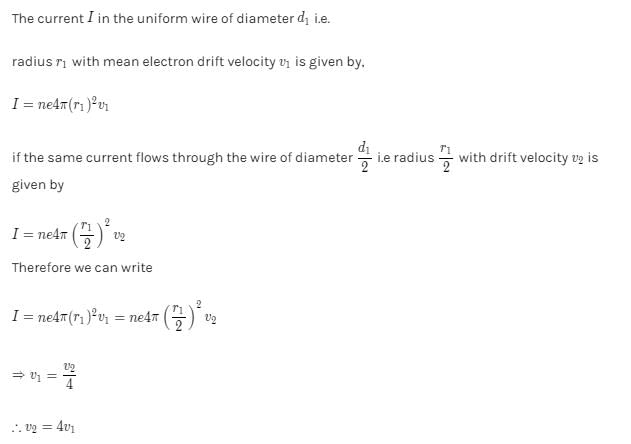
The current in a metallic conductor is plotted against voltage at two different temperatures T1 and T2. Which is correct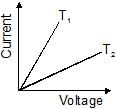
- a)T1 > T2
- b)T1 < T2
- c)T1 = T2
- d)none
Correct answer is option 'B'. Can you explain this answer?
The current in a metallic conductor is plotted against voltage at two different temperatures T1 and T2. Which is correct
a)
T1 > T2
b)
T1 < T2
c)
T1 = T2
d)
none
|
|
Vivek Rana answered |
According to Ohm's law R=V/I
Where R= resistance, V= Voltage, I= Current
Also R is directly proportional to temperature T and inversely proportional to the slope.
∴ from the above example
R1∝T1 and R2∝T2
but from given figure R1<R2
∴T1<T2
Where R= resistance, V= Voltage, I= Current
Also R is directly proportional to temperature T and inversely proportional to the slope.
∴ from the above example
R1∝T1 and R2∝T2
but from given figure R1<R2
∴T1<T2
emf is measured in- a)J.C
- b)J
- c)J/C
- d)J/C/m
Correct answer is option 'C'. Can you explain this answer?
emf is measured in
a)
J.C
b)
J
c)
J/C
d)
J/C/m
|
|
Rohan Singh answered |
Electromotive force, abbreviated emf (denoted and measured in volts), is the electrical intensity or "pressure" developed by a source of electrical energy such as a battery or generator. ... This potential difference can drive an electric current if an external circuit is attached to the terminals. It is commonly measured in units of volts, equivalent in the metre–kilogram–second system to one joule per coulomb of electric charge. In the electrostatic units of the centimetre–gram–second system, the unit of electromotive force is the statvolt, or one erg per electrostatic unit of charge.
On heating a conductor its resistance- a)depends on type of metal
- b)remains constant
- c)increases
- d)decreases
Correct answer is option 'C'. Can you explain this answer?
On heating a conductor its resistance
a)
depends on type of metal
b)
remains constant
c)
increases
d)
decreases
|
|
Rahul Bansal answered |
The resistance increases as the temperature of a metallic conductor increase, so the resistance is directly proportional to the temperature. When we increase the temperature the amplitude of vibration of atoms increases as a result of which the number of collision among the electrons and atom increases, and hence resistances increases.
- a)0.75 A
- b)1.05 A
- c)2 A
- d)3 A
Correct answer is 'A'. Can you explain this answer?
|
|
Rohan Singh answered |
Total inner voltage E = 2*3 = 6.0 V
Total resist. Rt = 0.2*3*7.4 = 8.0 ohm
circulating current I = E/Rt = 6/8 = 3/4 = 0.75 A
- a)yes
- b)No
- c)Can’t predict
- d)None of the above
Correct answer is 'A'. Can you explain this answer?

|
Vaishnavi Nayak answered |
In series connection of cells total internal resistance=nr total resistance of circuit=nR current is same potential difference is different so,I=nv/nR+nr I=V/R+r current is same as before in parallel connection of cells total internal resistance=r/n total resistance of circuit=R/n total current=nI potential difference is same nI=V/r/n+R/n I=V/R+r current is same as before
The Wheatstone bridge Principle is deduced using- a)Gauss’s Law
- b)Kirchhoff’s Laws
- c)Coulomb’s Law
- d)Newton’s Laws
Correct answer is option 'B'. Can you explain this answer?
The Wheatstone bridge Principle is deduced using
a)
Gauss’s Law
b)
Kirchhoff’s Laws
c)
Coulomb’s Law
d)
Newton’s Laws
|
|
Anjana Sharma answered |
PRINCIPLE: Wheatstone bridge principle states that when the bridge is balanced, the product of the resistance of the opposite arms are equal. The files that I had attached in which I had derived Wheatstone bridge equation using Kirchhoff law is useful to you.
Can you explain the answer of this question below:The ______ of changes in potential around any closed loop involving resistors and cells in a loop is zero.- A:product
- B:algebraic sum
- C:difference
- D:sum of absolute values
The answer is b.
The ______ of changes in potential around any closed loop involving resistors and cells in a loop is zero.
A:
product
B:
algebraic sum
C:
difference
D:
sum of absolute values
|
|
Lavanya Menon answered |
In accordance with Kirchhoff’s second law i.e. Kirchhoff’s voltage law (KVL), the algebraic sum of all the potential differences in a closed electric circuit or closed loop that contains one or more cells and resistors is always equal to zero.
This law is popularly called the law of conservation of voltage.
This law is popularly called the law of conservation of voltage.
A carbon resistor is marked in green, red, and orange bands. The approximate resistance of the resistor is
- a)52 x 103 Ω
- b)25000 Ω
- c)5 x 102 Ω
- d)5 x 104 Ω
Correct answer is option 'A'. Can you explain this answer?
A carbon resistor is marked in green, red, and orange bands. The approximate resistance of the resistor is
a)
52 x 103 Ω
b)
25000 Ω
c)
5 x 102 Ω
d)
5 x 104 Ω
|
|
Anjana Sharma answered |
To determine the resistance of a carbon resistor based on the color bands, we need to refer to the standard resistor color code. The colors represent digits and multipliers as follows:
- Green: 5
- Red: 2
- Orange: Multiplier of 10^3 (1,000)
Given the color bands: Green, Red, Orange
The resistance value is calculated as follows:
- First digit: Green = 5
- Second digit: Red = 2
- Multiplier: Orange = 10^3 (1,000)
So the resistance is:
Resistance=(52)×10^3 ohms=52,000 ohms=52 kilo-ohms
Answer: The approximate resistance of the resistor is 52 kΩ.
- a)0.11 ohm
- b)0 ohm
- c)0. 12 ohm
- d)1.1 ohm
Correct answer is 'B'. Can you explain this answer?
|
|
Rajeev Saxena answered |
Total emf = 3 x 4 = 12 V
Total resistance = 6 + 3r
Current in the circuit = 2 A
Using ohms law
2 = 12/ (6+3r)
2(6+3r)=12
12+6r=12
6r = 12-12 = 0
r = 0/6 = 0
The resistance of some substances become zero at very low temperature , then these substances are called- a)good conductors
- b)super conductors
- c)bad conductors
- d)semi conductors
Correct answer is option 'B'. Can you explain this answer?
The resistance of some substances become zero at very low temperature , then these substances are called
a)
good conductors
b)
super conductors
c)
bad conductors
d)
semi conductors

|
Dr Manju Sen answered |
Superconductivity is a phenomenon of exactly zero electrical resistance and expulsion of magnetic fields occurring in certain materials when cooled below a characteristic critical temperature.
Even near absolute zero, a real sample of a normal conductor shows some resistance. In a superconductor, the resistance drops abruptly to zero when the material is cooled below its critical temperature. An electric current flowing through a loop of superconducting wire can persist indefinitely with no power source.
Example: - Liquid Nitrogen.
Even near absolute zero, a real sample of a normal conductor shows some resistance. In a superconductor, the resistance drops abruptly to zero when the material is cooled below its critical temperature. An electric current flowing through a loop of superconducting wire can persist indefinitely with no power source.
Example: - Liquid Nitrogen.
The terminal voltage across a battery of emf E can be- a)0
- b)> E
- c)< E
- d)All of above
Correct answer is option 'D'. Can you explain this answer?
The terminal voltage across a battery of emf E can be
a)
0
b)
> E
c)
< E
d)
All of above
|
|
Krishna Iyer answered |
Potential difference(V) across the terminals of a cell
i. Discharging of cell when cell is supplying current,
Therefore, V=VP+VQ=E-Ir, i,r., V<E
ii. charging of cell when cell is taking current,
V=VP-VQ=E+Ir, i.e., V>E
iii. When the cell is short circuited i.e., external resistance is zero,
=> I=E/r
=> V=VP-VQ=E-Ir=0 i.e., V=0
i. Discharging of cell when cell is supplying current,
Therefore, V=VP+VQ=E-Ir, i,r., V<E
ii. charging of cell when cell is taking current,
V=VP-VQ=E+Ir, i.e., V>E
iii. When the cell is short circuited i.e., external resistance is zero,
=> I=E/r
=> V=VP-VQ=E-Ir=0 i.e., V=0
In a meter bridge experiment a balance point is obtained at a distance of 60 cm from the left end when unknown resistance R is in a left gap and 8 ohms resistor is connected in the right gap. When the position of R and 8 ohm resistor is interchanged the balance point will be at distance of- a)40 cm
- b)30 cm
- c)50 cm
- d)60 cm
Correct answer is option 'A'. Can you explain this answer?
In a meter bridge experiment a balance point is obtained at a distance of 60 cm from the left end when unknown resistance R is in a left gap and 8 ohms resistor is connected in the right gap. When the position of R and 8 ohm resistor is interchanged the balance point will be at distance of
a)
40 cm
b)
30 cm
c)
50 cm
d)
60 cm
|
|
Jyoti Sengupta answered |
60/40 = l/100-l, = R/8
so R=12
now changed position 8 is proportional to l and 12 to (100-l)
8/12 = l/100-l
l = 40ohm
The resistance in ohms in the four arms of a Wheatstone bridge are as follows. In which combination of the following is the bridge balanced?
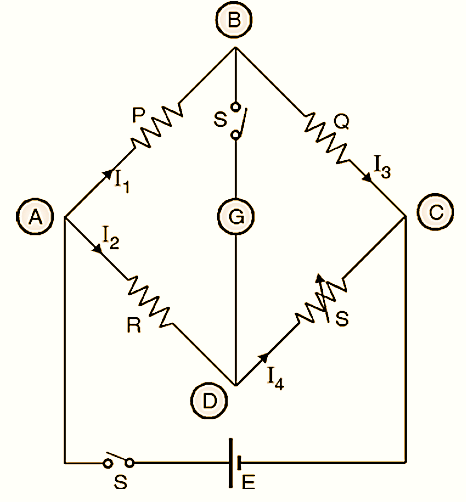
- a)P, R, S, Q
- b)P, R, Q, S
- c)Q, P, R, S
- d)S, R, P, Q
Correct answer is option 'B'. Can you explain this answer?
The resistance in ohms in the four arms of a Wheatstone bridge are as follows. In which combination of the following is the bridge balanced?


a)
P, R, S, Q
b)
P, R, Q, S
c)
Q, P, R, S
d)
S, R, P, Q
|
|
Shreya Singh answered |
Wheat stone bridge follows.P/Q=R/S, condition. b) P=2, Q=3 ,R= 4,S=62/3=4/62/3= 2/3...
A storage battery is connected to a charger for charging with a voltage of 12.5 Volts. The internal resistance of the storage battery is 1 W. When the charging current is 0.5 A, the emf of the storage battery is :- a)13 Volts
- b)12.5 Volts
- c)12 Volts
- d)1.5 Volts
Correct answer is option 'C'. Can you explain this answer?
A storage battery is connected to a charger for charging with a voltage of 12.5 Volts. The internal resistance of the storage battery is 1 W. When the charging current is 0.5 A, the emf of the storage battery is :
a)
13 Volts
b)
12.5 Volts
c)
12 Volts
d)
1.5 Volts
|
|
Riya Banerjee answered |
Given A storage battery is connected to a charger for
charging with a voltage of 12.5 Volts. The internal
resistance of the storage battery is 1 ohm. When the
charging current is 0.5 A, the emf of the storage
battery is:
When the battery is charging
We know that
V = e + i r
V = 12.5, i = 0.5, r = 1
12.5 = e + 0.5 x 1
12.5 = e + 0.5
e = 12.5 – 0.5
e = 12 v
charging with a voltage of 12.5 Volts. The internal
resistance of the storage battery is 1 ohm. When the
charging current is 0.5 A, the emf of the storage
battery is:
When the battery is charging
We know that
V = e + i r
V = 12.5, i = 0.5, r = 1
12.5 = e + 0.5 x 1
12.5 = e + 0.5
e = 12.5 – 0.5
e = 12 v
Read the following statements carefully :Y : The resistivity of a semiconductor decreases with increases of temperature.Z : In a conducting solid, the rate of collision between free electrons and ions increases with increase of temperature.Select the correct statement from the following- a)Y is true but Z is false
- b)Y is false but Z is true
- c)Both Y and Z are true
- d)Y is true and Z is the correct reason for Y
Correct answer is option 'C'. Can you explain this answer?
Read the following statements carefully :
Y : The resistivity of a semiconductor decreases with increases of temperature.
Z : In a conducting solid, the rate of collision between free electrons and ions increases with increase of temperature.
Select the correct statement from the following
a)
Y is true but Z is false
b)
Y is false but Z is true
c)
Both Y and Z are true
d)
Y is true and Z is the correct reason for Y
|
|
Harsh Singhal answered |
Bcz on resistivity decrease resistance decrease for semiconductor
for conductor frequency of collision increase so from
R=2ML/NE^2at
on time decrease resistance increase
for conductor frequency of collision increase so from
R=2ML/NE^2at
on time decrease resistance increase
Current provided by a battery is maximum when- a)internal resistance is equal to external resistance
- b)internal resistance is greater then external resistance
- c)internal resistance is less than external resistance
- d)none of these
Correct answer is option 'A'. Can you explain this answer?
Current provided by a battery is maximum when
a)
internal resistance is equal to external resistance
b)
internal resistance is greater then external resistance
c)
internal resistance is less than external resistance
d)
none of these
|
|
Pooja Mehta answered |
Current provided by a battery is maximum when internal resistance is equal to external resistance. As a battery discharges, not only does it diminish its internal store of energy, but its internal resistance also increases (as the electrolyte becomes less and less conductive), and its open-circuit cell voltage decreases (as the chemicals become more and more dilute). The most deceptive change that a discharging battery exhibits is increased resistance.
The equivalent emf of two cells (with ε1 > ε2) in series if we connect two negative electrodes of adjacent cells is- a)εequivalent =

- b)εequivalent =

- c)εequivalent = ε2 - ε1 (ε1 > ε2)
- d)εequivalent = ε1 - ε2 (ε1 > ε2)
Correct answer is option 'D'. Can you explain this answer?
The equivalent emf of two cells (with ε1 > ε2) in series if we connect two negative electrodes of adjacent cells is
a)
εequivalent = 
b)
εequivalent = 
c)
εequivalent = ε2 - ε1 (ε1 > ε2)
d)
εequivalent = ε1 - ε2 (ε1 > ε2)

|
Sushil Kumar answered |
When we connect cells to form a battery, we join opposite ends(+ve with -ve and vice versa) to get supporting emf, i.e. net emf get added, but when we join the same polarities(-ve with -ve, like in the question), they oppose each other, hence net emf is the difference b/w them.
The expression for equivalent emf when two cells of emf’s
εeq = ε1 - ε2 (ε1> ε2)
The expression for equivalent emf when two cells of emf’s
εeq = ε1 - ε2 (ε1> ε2)
Two wires each of radius of cross section r but of different materials are connected together end to end (in series). If the densities of charge carriers in the two wires are in the ratio 1 : 4, the drift velocity of electrons in the two wires will be in the ratio.- a)1 : 2
- b)2 : 1
- c)4 : 1
- d)1 : 4
Correct answer is option 'C'. Can you explain this answer?
Two wires each of radius of cross section r but of different materials are connected together end to end (in series). If the densities of charge carriers in the two wires are in the ratio 1 : 4, the drift velocity of electrons in the two wires will be in the ratio.
a)
1 : 2
b)
2 : 1
c)
4 : 1
d)
1 : 4
|
|
Rohan Singh answered |

Chapter doubts & questions for Current Electricity - Physics for Grade 12 2025 is part of Grade 12 exam preparation. The chapters have been prepared according to the Grade 12 exam syllabus. The Chapter doubts & questions, notes, tests & MCQs are made for Grade 12 2025 Exam. Find important definitions, questions, notes, meanings, examples, exercises, MCQs and online tests here.
Chapter doubts & questions of Current Electricity - Physics for Grade 12 in English & Hindi are available as part of Grade 12 exam.
Download more important topics, notes, lectures and mock test series for Grade 12 Exam by signing up for free.
Physics for Grade 12
128 videos|249 docs|180 tests
|


